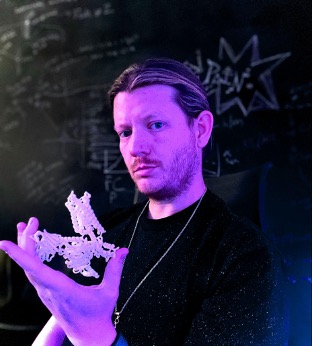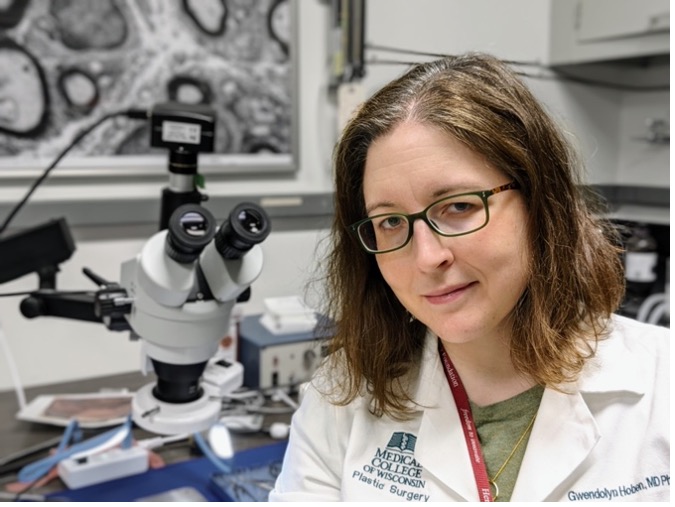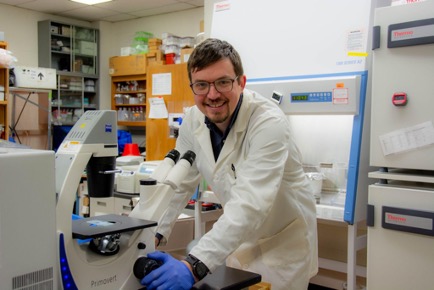|

(Photo: Kate Townsend Creasy)
Gregory Corder, University of Pennsylvania
Assistant Professor, Psychiatry, Neuroscience
[Link to: https://corderlab.com]
B.S., Tulane University
Ph.D., University of Kentucky
The mission of the Corder Lab at the University of Pennsylvania aims to decipher the neural basis of how the brain generates the perception of pain, and how pathological dysfunction within these brain networks promotes the transition to chronic pain and drug abuse. Using advanced in vivo imaging of neural activity, neuroanatomical tracing, and optical neuromodulation techniques, our group deconstructs the brain circuits and molecular mechanisms involved in pain and emotion. From these basic science investigations, we work collaboratively with others—chemists, bioengineers, and clinician-scientists—to identify translational targets for the development of novel therapeutics that reduce mental health disorders associated with chronic pain and decrease the reliance on prescription opioids.
What will funding from the Award in Pain allow you to do?
I have been interested in the control of pain by the body’s own painkiller system—the endogenous opioid peptides and receptors—since I started my scientific career. My mentors all trained under some of the key neuroscientists who first described this opioid system, which is a part of a set of connected neurons termed the descending pain modulatory system. Key questions on neuromodulation have lingered for years. Now, our lab is excited to apply several new technologies that will allow us to “read” the real-time activity between opioid and pain signals in the brain, and then “re-write” that activity using light and genetic engineering. We believe the science supported by the Rita Allen Foundation Award in Pain will serve as a critical launchpad for these investigations toward meaningful new and safe ways to treat pain that leverage endogenous opioids with temporal and anatomical precision.
How did you enter this career path? Was there anyone or anything that particularly inspired you?
After Hurricane Katrina and my semester off from Tulane University, I pivoted away from my cellular biology major and I became consumed with meditation and philosophy of the mind, in particular the work of Daniel C. Dennett. With this new urge to understand how my own mind worked, I enrolled in my first neuroscience classes and convinced a professor to let me do a senior thesis project with them to study the neuroscience of pain, even though I had no lab experience. It was this 10-month period of trying to fuse philosophy and science that kicked off my career, and I have been just doing these same things that I love for the last 15 years.
What is your favorite science-related book?
During the same period of intense philosophy at Tulane, I took a semesters-long course on Charles Darwin’s life and career. Reading On the Origin of Species was amazing, not only for the historically groundbreaking ideas, but for Darwin’s clear literary style that I found lyrical and entertaining; it remains at the top of my favorite science books today (alongside Consciousness Explained by Dan Dennett).

[Photo: Dustin Ragan]
Gwendolyn Hoben, Medical College of Wisconsin
Assistant Professor, Plastic Surgery; Cell biology, neurobiology, and anatomy
[Link to: https://www.mcw.edu/departments/plastic-surgery/research/hoben-laboratory]
Ph.D., Rice University
M.D., Baylor College of Medicine
In conjunction with Margaret and William R. Hearst III
A truly new way to approach a problem surgically is rare and that is what has made targeted muscle reinnervation so fascinating. The unexpected observation that TMR could prevent and reduce residual limb and phantom limb pain in amputees has already impacted the lives of hundreds of patients. The Hoben laboratory has taken TMR from the bedside back to the bench to better elucidate how surgically rearranging nerves affects pain pathways. These changes in nerve connections alter neurons, the fundamental cells of the nervous system. Characterizing the changes in these cells may help identify critical components of residual and phantom limb pain that can be targeted for pain relief. Ultimately, we hope that by better understanding the foundation of TMR pain relief we will be able to apply TMR principles to amputees with chronic pain and other forms of nerve injuries.
What will funding from the Award in Pain allow you to do?
The generous funding of the Rita Allen Foundation will allow us to expand our tools for examining the effects of these nerve connections, especially looking more centrally in the nervous system at electrical changes. Using these tools, we will better identify targets to manipulate to improve phantom limb pain in amputees.
What is your favorite science-related book?
The Beautiful Brain: The Drawings of Santiago Ramon y Cajal. I like to tease my students by suggesting they model their lab notebooks after Ramon y Cajal, and then I point to some of the drawings that I have framed in my office. His observations of the nervous system with just light microscopy are simply remarkable. We work in research to better understand nature and use that knowledge toward a purpose. In doing so there is this extra reveal, beyond the understanding, of the beauty of these structures. A bad day in the lab can be made a little bit better looking at some of these images and being re-inspired to keep looking.

[Photo: Angela Mickle]
Aaron Mickle, University of Florida
Assistant Professor, Psychological Sciences
[Link to: https://mickle.physio.vetmed.ufl.edu]
B.S., University of Wisconsin – La Crosse
Ph.D., University of Iowa
In conjunction with Margaret and Will Hearst
Chronic pain affects millions of people in the United States, and its socioeconomic burden is currently unprecedentedly high due to the opioid crisis. Almost everyone has either experienced chronic pain or had a family member affected by it. For these reasons, I am passionate about pain research and discovering new therapeutic options for chronic pain patients. Our lab uses a “cell to model organism” strategy to pursue the goal of understanding and delineating the causes of bladder pain dysfunction. We have multiple avenues of research that support this end goal: 1) Pursuing the development of neuromodulation strategies to alleviate bladder dysfunction following spinal cord injury, 2) Evaluating the role of urothelial cells, the cells that line the bladder, in bladder pain and dysfunction, and 3) Developing implantable biosensor and neuromodulatory technology to study bladder disorders and pain.
What will funding from the Award in Pain allow you to do?
This funding will allow me to steer my research in a new and exciting direction. We will develop new tools to evaluate the role of the cells that line the bladder in bladder pain diseases. The award will provide funds for many aspects of the research, including supplies, equipment, and most importantly, to support students or postdocs that will engage in this research.
How did you enter this career path? Was there anyone or anything that particularly inspired you?
I have always been interested in science, particularly discovering the unknown. Problem-solving associated with scientific discovery has always fascinated me. After my undergraduate degree, I knew I wanted a research career, but I was unsure to what extent and how to do it. After looking at many different jobs, I accepted a position as a laboratory technician at the Medical College of Wisconsin studying visceral pain. Although it was an entry-level position, my mentors, Adrian Miranda and Jyoti Sengupta actively supported my career development. The research I performed in their lab ignited my fascination with neuroscience and my pursuit of a career in pain research. They provided me with opportunities to present my work at national meetings and author multiple manuscripts, which offered me the experience and credentials to get into graduate school. I am forever thankful for their mentorship that helped to guide my early career. Without their support in pursuing a graduate degree, I would not be where I am.

(Photo: Nicole Scheff)
Nicole Scheff, University of Pittsburgh
Assistant Professor, Neurobiology
[Link to: https://schefflab.pitt.edu/ ]
Ph.D., University of Pittsburgh
Head and neck squamous cell carcinoma causes severe pain, increased stress, and reduced quality of life, which exceeds the levels seen in other cancers. Beyond sensory/pain signaling, the peripheral nervous system has been identified as a component of the cancer microenvironment and may be involved in modulating tumor progression and tumor-associated immunity. The cancer microenvironment is comprised of stromal cells, glial cells, immune cells, neurons, (e.g., motor, sensory, sympathetic) and proliferating tumor cells. The lab seeks to integrate the neurobiology, cancer biology, and immunology fields in order to fully appreciate neural-immune-cancer communication and develop a more holistic approach to novel cancer pain treatment. The goal of my research is to understand how peripheral neurons evolve and adapt during cancer initiation and growth, and to investigate whether therapy targeted to neurons innervating the cancer can alleviate pain and slow tumorigenesis.
How did you enter this career path? Was there anyone or anything that particularly inspired you?
My father, a Professor of Anatomy and Neurobiology at the University of Kentucky, taught me at a very young age to score electron micrographs for synapse loss in different areas of the cerebral cortex. This “father-daughter quality time” sealed the deal for me to become a neurobiologist. Indeed, the backbone of my success is without a doubt due to the phenomenal mentorship I have received and continue to receive today. Brian Davis, who introduced me to the field of cancer pain and is a pioneer in the cancer neurobiology field, and Michael Gold, my doctoral mentor, both continue to inspire me to go beyond normal limits and to try out new and different ideas that might contradict current views. I have been extremely lucky to have received such strong training, mentorship, and support throughout my career and I look forward to continuing to push the field forward and support other upcoming scientists.
|